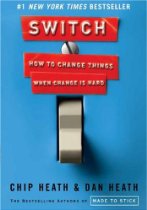 The title of this post comes from the title of a book called Looking for the Good Stuff: A Guide to Enjoying and Appreciating Life by Bob New and Kathleen Rich-New.
The title of this post comes from the title of a book called Looking for the Good Stuff: A Guide to Enjoying and Appreciating Life by Bob New and Kathleen Rich-New.
It’s a book we love as a terrific introduction to Appreciative Inquiry: it’s a small book and an easy read that covers the essential principles and components of AI.
But this post was actually inspired by a Fast Company article that talks about a book called Switch: How to Change Things When Change is Hard, written by Chip and Dan Heath.
This second book is not about Appreciative Inquiry. But, as I discovered, the authors are exploring similar themes!
If you read the article, you’ll find the authors are recommending as a first step the same approach used by Appreciative Inquiry practitioners:
Find a bright spot and clone it.
That’s the first step to fixing everything from addiction to corporate malaise to malnutrition. A problem may look hopelessly complex. But there’s a game plan that can yield movement on even the toughest issues. And it starts with locating a bright spot — a ray of hope.
 The article then goes on to share a few of the stories the Heath Brothers discovered that demonstrate the success achieved through focusing on what works then doing more of it.
The article then goes on to share a few of the stories the Heath Brothers discovered that demonstrate the success achieved through focusing on what works then doing more of it.
As we say in Appreciative Inquiry, it’s about “starting from the positive core”.
Reflecting on the article, I’m reminded once more of the strong connections between Appreciative Inquiry and other areas of work.
For example,there’s Solution Focused Therapy (also called Brief Therapy), which focuses on what clients want to achieve, instead of the problems that brought them to therapy in the first place. Like Appreciative Inquiry, the roots of solution focused therapy like in social constructionism theory – how we make meaning from our experiences:
The approach does not focus on the past, but instead, focuses on the present and future. The therapist/counselor uses respectful curiosity to invite the client to envision their preferred future and then therapist and client start attending to any moves towards it whether these are small increments or large changes. To support this, questions are asked about the client’s story, strengths and resources, and about exceptions to the problem.
Then there’s Narrative Therapy, initially developed by Australian Michael White and David Epston, of New Zealand in the 1970s and 1980s. This approach has therapists also ‘looking for the good stuff’ in working with people to help them story and re-story their lives:
Narrative therapy seeks to be a respectful, non-blaming approach to counselling and community work, which centres people as the experts in their own lives. It views problems as separate from people and assumes people have many skills, competencies, beliefs, values, commitments and abilities that will assist them to reduce the influence of problems in their lives.
Thirdly, we have Asset Based Community Development(ABCD):
Building on the skills of local residents, the power of local associations, and the supportive functions of local institutions, asset-based community development draws upon existing community strengths to build stronger, more sustainable communities for the future.
 And these are only three of the disciplines in which the approach has very close alignment with Appreciative Inquiry. It seems to me the trend towards this kind of strength-focused approach is a global one that is continuing to gain in usage around the world. It would seem people are wanting a change from problem-saturated, deficit conversations. They are eager for an alternative – one that focuses on strengths, hopes and possibilities.
And these are only three of the disciplines in which the approach has very close alignment with Appreciative Inquiry. It seems to me the trend towards this kind of strength-focused approach is a global one that is continuing to gain in usage around the world. It would seem people are wanting a change from problem-saturated, deficit conversations. They are eager for an alternative – one that focuses on strengths, hopes and possibilities.
They’ve found that focusing on problems does not, in the end, change anything very much. Instead, by concentrating on ‘looking for the good stuff‘ we can be far more successful in working together to create a brighter, more successful future.
 Our monthly newsletter
Our monthly newsletter
Speak Your Mind